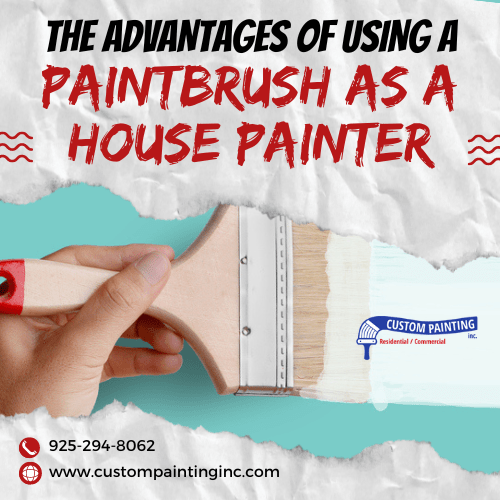Using a paintbrush for house painting offers several advantages. While rollers and sprayers are popular choices, paint brushes provide a level of control and precision that is hard to match. They are especially useful for detailed work and small areas. This article will discuss the benefits of using a paintbrush for your house painting projects.
What Does a Paintbrush Do for House Painting?
Using a paintbrush for house painting has many benefits. Here are some key factors that make paintbrushes valuable tools:
Precision
Paint brushes provide precise control for painting edges, corners, and detailed areas. This helps create clean lines and ensures a professional finish.
Versatility
They can be used on a variety of surfaces including walls trim and furniture. Different brush sizes and shapes can handle various tasks effectively.
Control
A paintbrush allows for better control over the amount of paint applied. This helps avoid drips and achieve a consistent finish.
Accessibility
Paintbrushes can reach tight spaces and awkward angles that rollers and sprayers cannot. This makes them ideal for painting around fixtures and in narrow areas.
Detail Work
For intricate designs and patterns, a paintbrush is the best tool. It allows for the careful application of paint in small areas, ensuring accuracy.
How to Pick the Right Paintbrush for the Job
While all paintbrushes can be used for house painting, there are a few that are better in terms of precision and versatility compared to the others. Check out these tips to help you pick the right brush:
Consider the Bristle Type
The type of bristle you choose depends on the paint you are using. Synthetic bristles are best for water-based paints as they do not absorb water and maintain their shape. Natural bristles are better for oil-based paints because they hold more paint and provide a smoother finish.
Using the right bristle type ensures better paint application and durability of the brush. For hybrid paints that contain both oil and water-based elements a high-quality synthetic bristle brush is a good choice as it can handle both types effectively.
Match the Brush Size to the Job
The size of the brush should match the area you are painting. A small brush (1 to 2 inches) is ideal for trim and detail work. A medium brush (2.5 to 3 inches) works well for cutting around edges and corners. A large brush (4 inches or more) is suitable for painting large flat surfaces.
Using the correct brush size can save time and effort. It also helps ensure even coverage and a cleaner finish. Having a variety of sizes on hand can be helpful for different parts of your project.
Choose the Right Brush Shape
Brushes come in different shapes like flat, angled and round. Flat brushes are great for large flat areas and produce a smooth finish. Angled brushes are perfect for cutting in and getting into corners and edges. Round brushes are used for detail work and decorative painting.
Selecting the right brush shape helps you achieve the desired effect and reach tricky areas. Angled brushes, in particular, can make painting around trim and corners much easier and cleaner.
Look at the Brush Quality
High-quality brushes may cost more, but they often deliver better results and last longer. Look for brushes with securely attached bristles that do not shed. A comfortable handle is also important for ease of use over long periods.
Investing in a good-quality brush can make a noticeable difference in your painting experience. It can provide better control and a finer finish, which is especially important for detailed work and larger projects.
Test the Flexibility
The flexibility of the bristles affects how the paintbrush performs. Stiff bristles are good for exterior and rough surfaces as they can handle thicker paints. Softer bristles are better for interior work and fine finishes where a gentle touch is needed.
Testing the flexibility before you start can help you choose the right brush for your specific project. Flexibility affects how well the brush holds paint and how smoothly it applies it to the surface.
Should the Paint Also Matter for House Painting?
When painting your house choosing the right paint is just as important as selecting the right tools. The type of paint you use can affect the finish durability and overall appearance of your project. There are many factors to consider including the paint’s base color quality and finish.
Water-based paints are popular for their easy cleanup and quick drying time. They are less likely to yellow over time and emit fewer fumes. Oil-based paints offer a durable finish that is ideal for high-traffic areas but they take longer to dry and require solvents for cleanup.
The quality of the paint matters too. Higher quality paints often provide better coverage and longer-lasting results. While they may cost more upfront they can save you time and money in the long run by reducing the need for multiple coats and frequent touch-ups.
Choosing the right finish is also important. Flat or matte finishes hide imperfections well but can be harder to clean. Satin and eggshell finishes are easier to clean and offer a slight sheen. Glossy finishes are very durable and easy to clean, but they can also highlight imperfections on the surface.
In summary, the paint you choose plays a crucial role in the success of your house painting project. Consider the type, quality, and finish of the paint to achieve the best results for your specific needs.
Conclusion
As evident in this article, using a paintbrush for house painting offers many advantages. While they are smaller than rollers and sprayers, paint brushes still have various uses for house painters.
If you need professional painting services, you can contact Custom Painting Inc. Call us at 925-294-8062 or fill out a Contact Form to learn more about how we can help with your painting projects.



